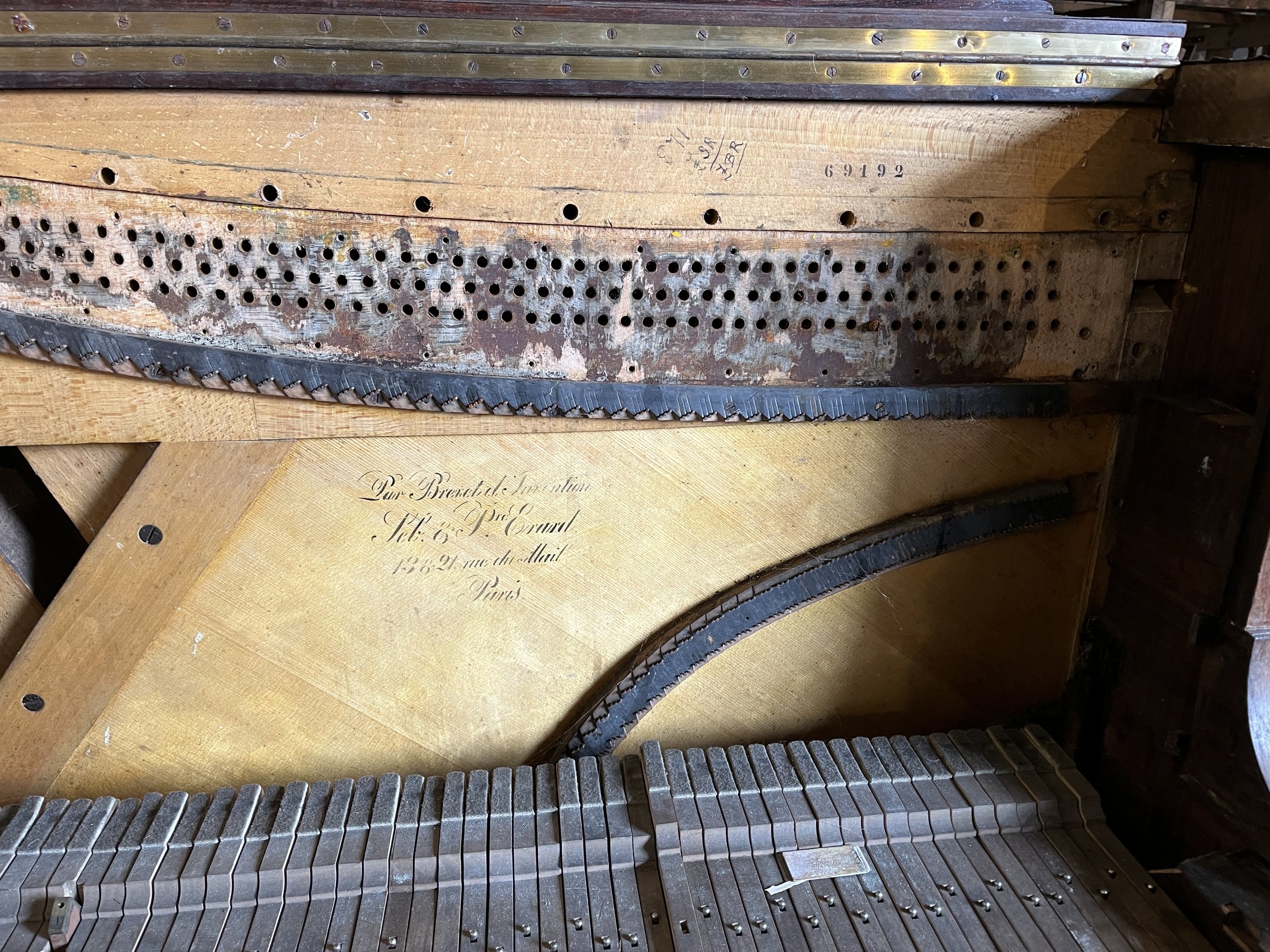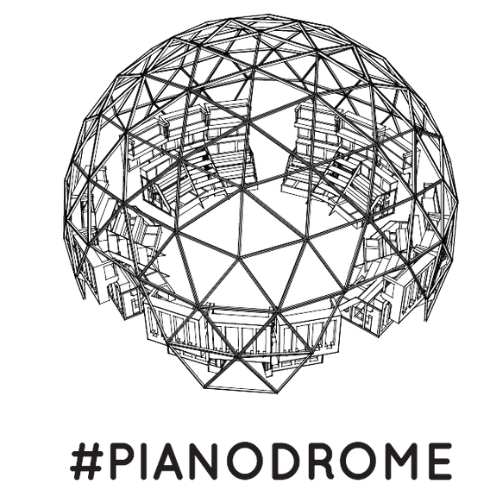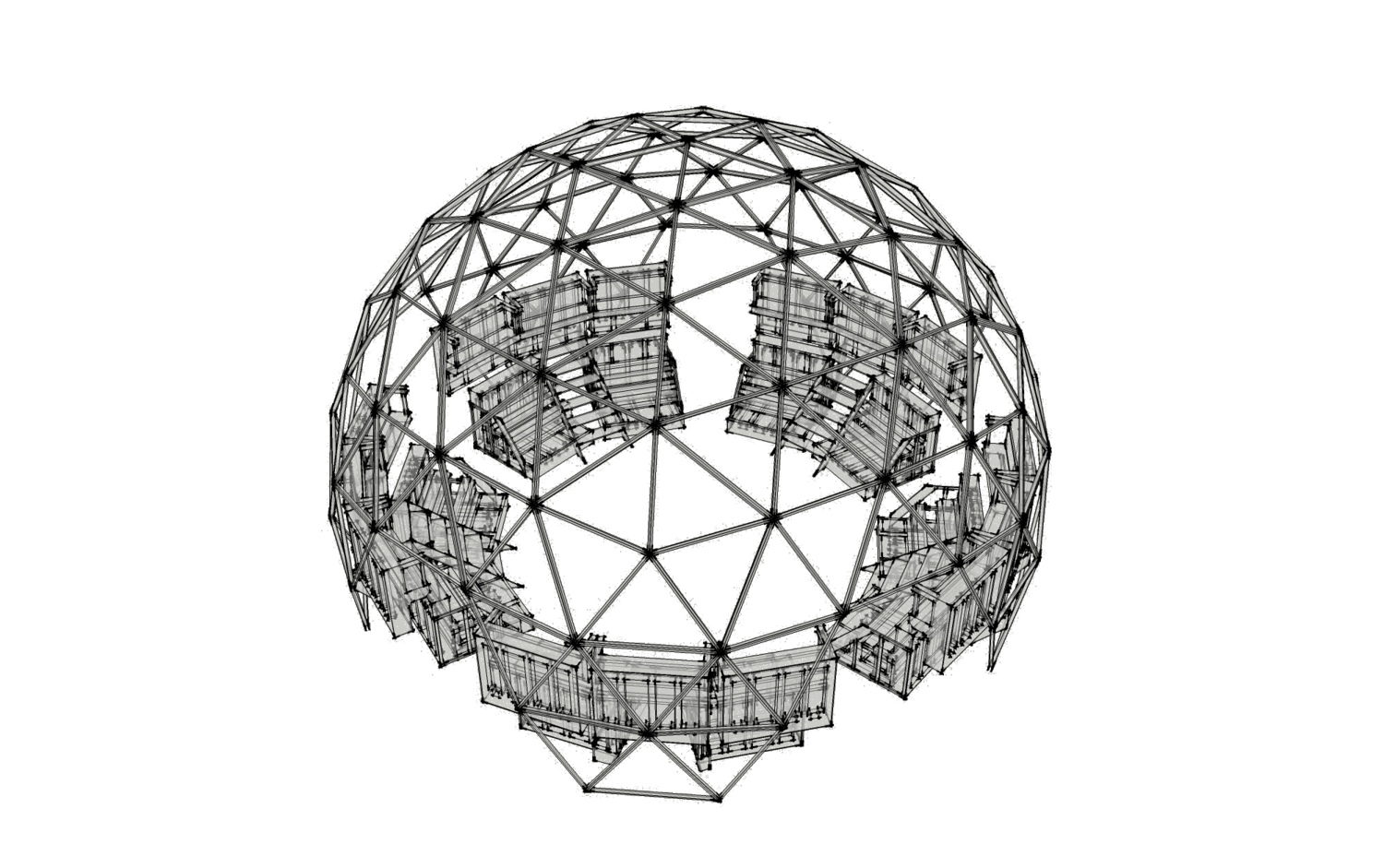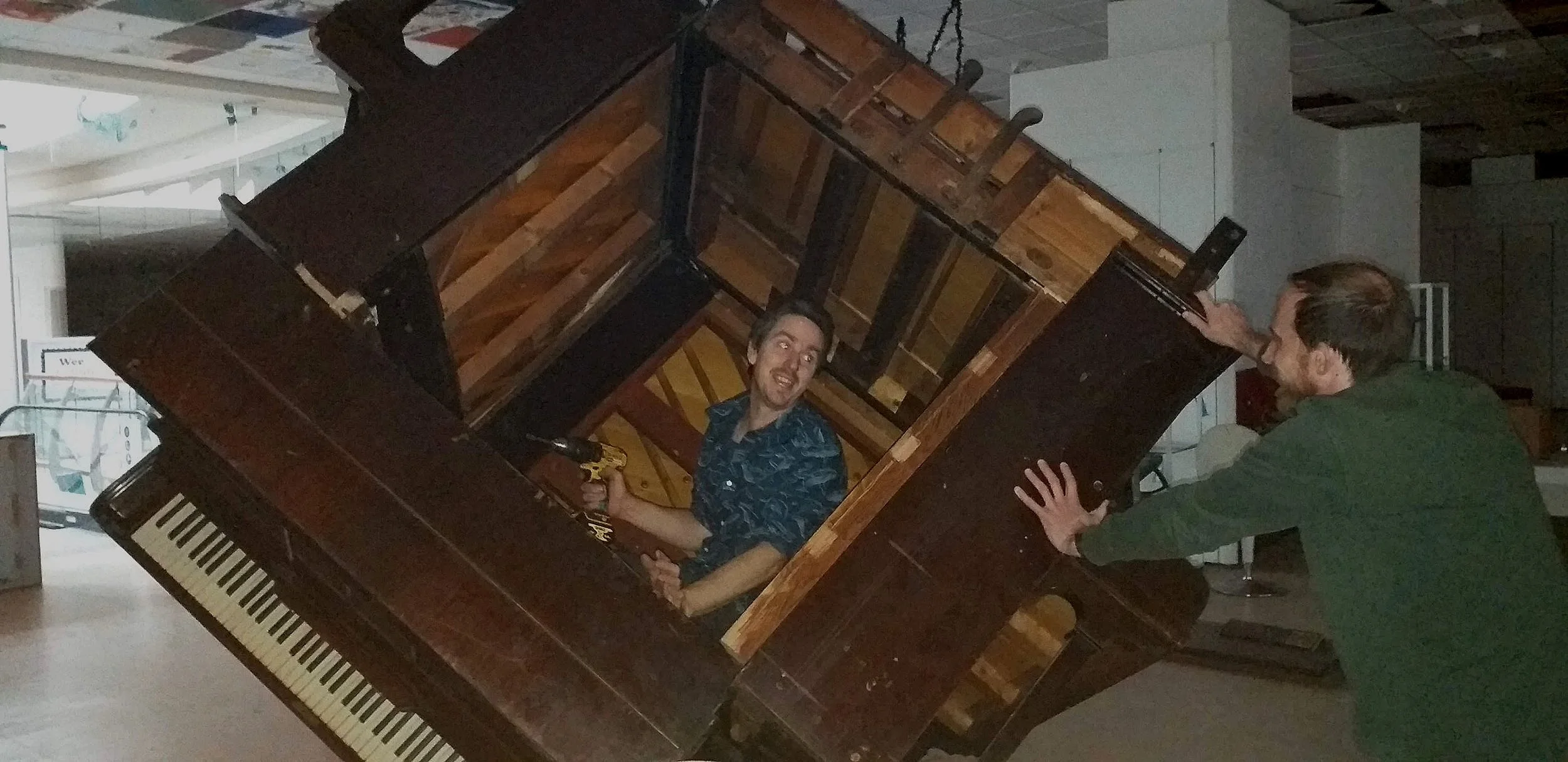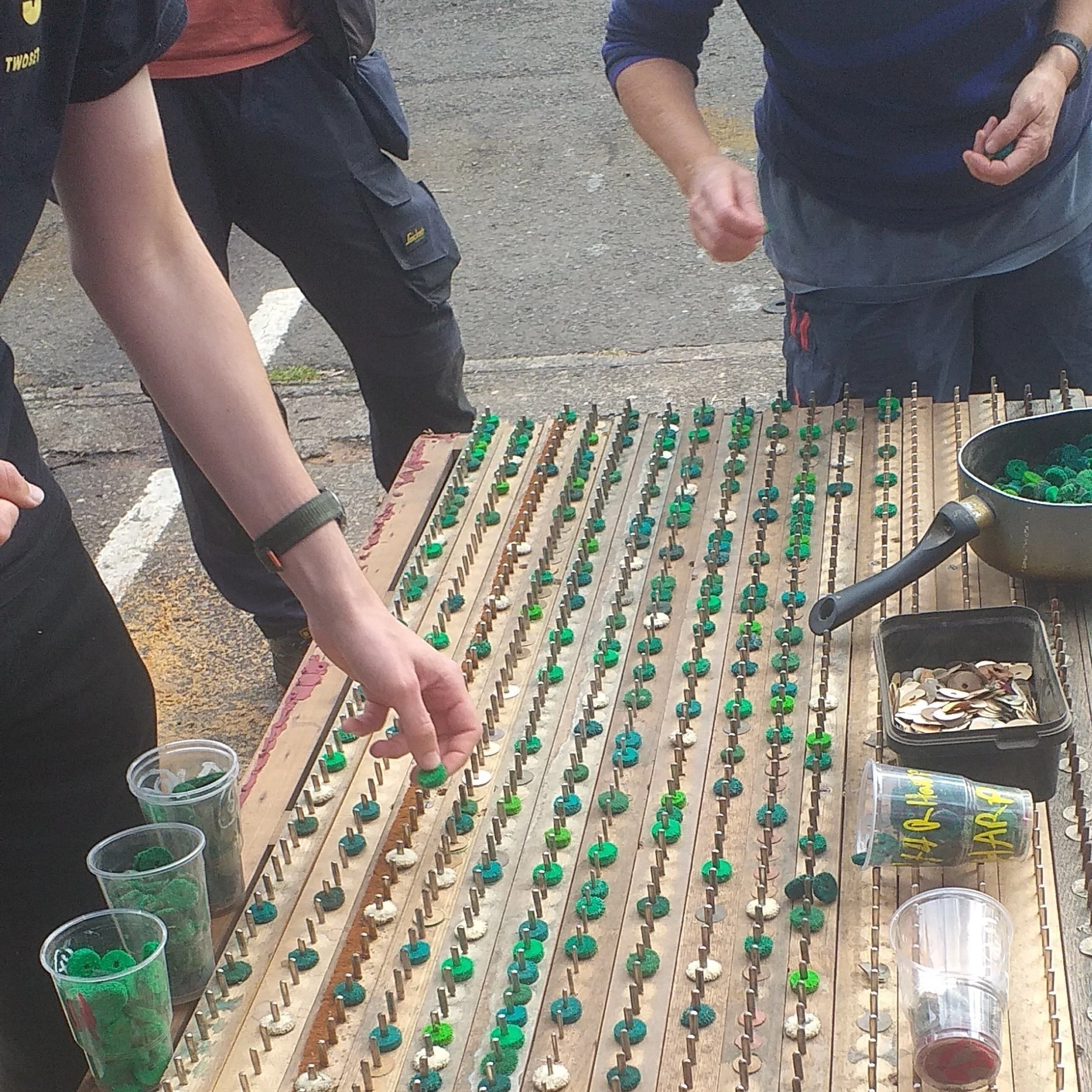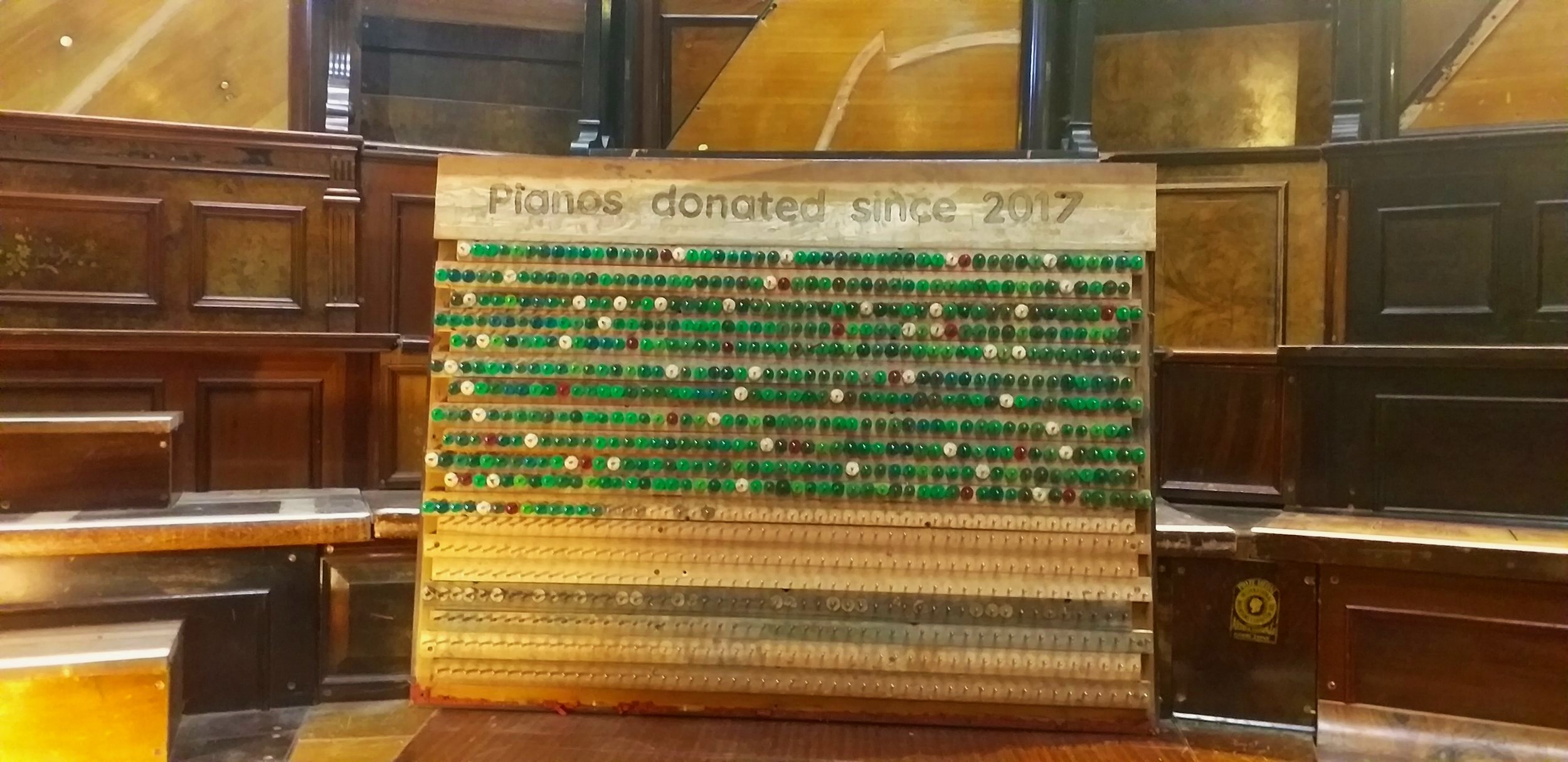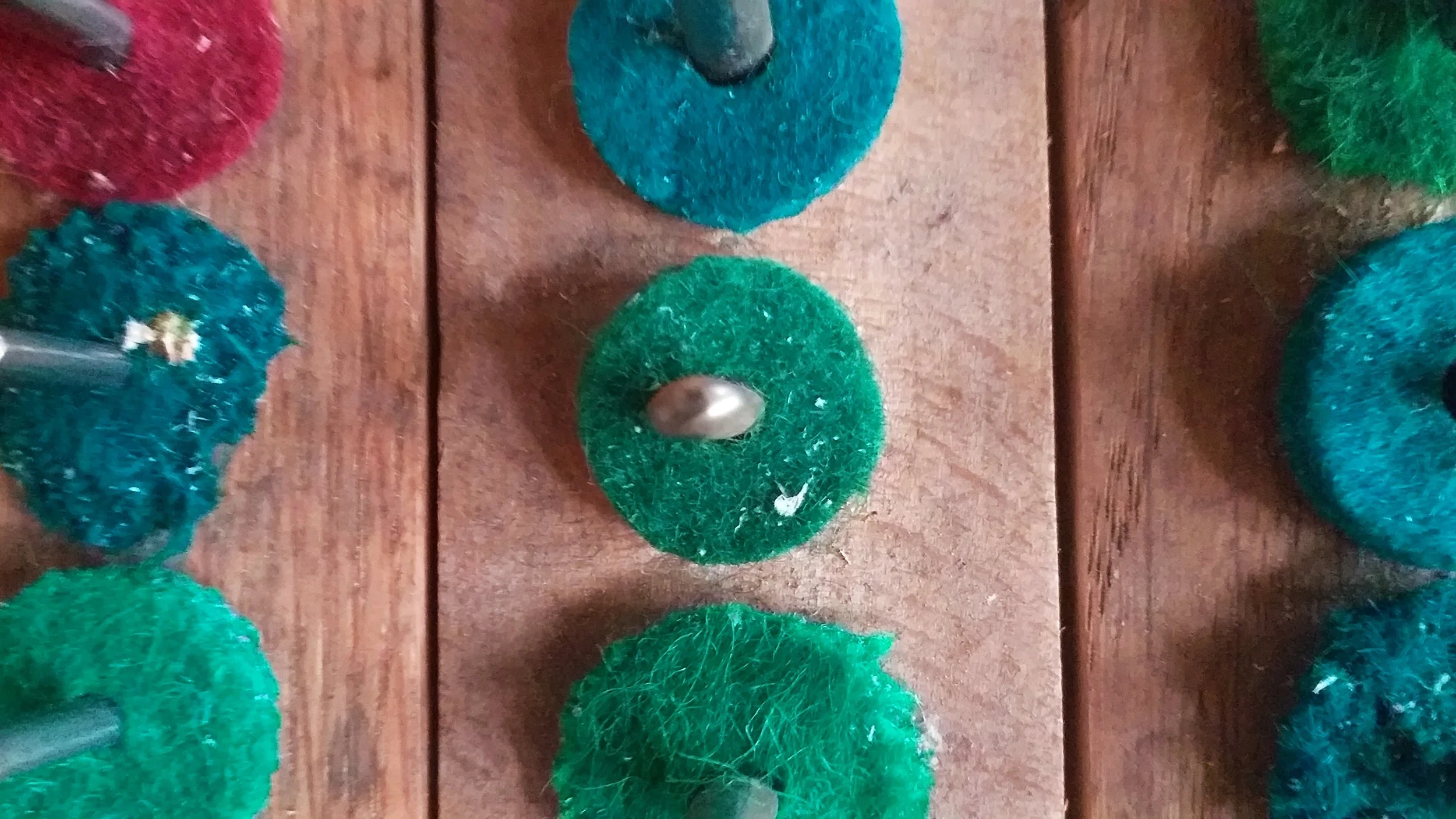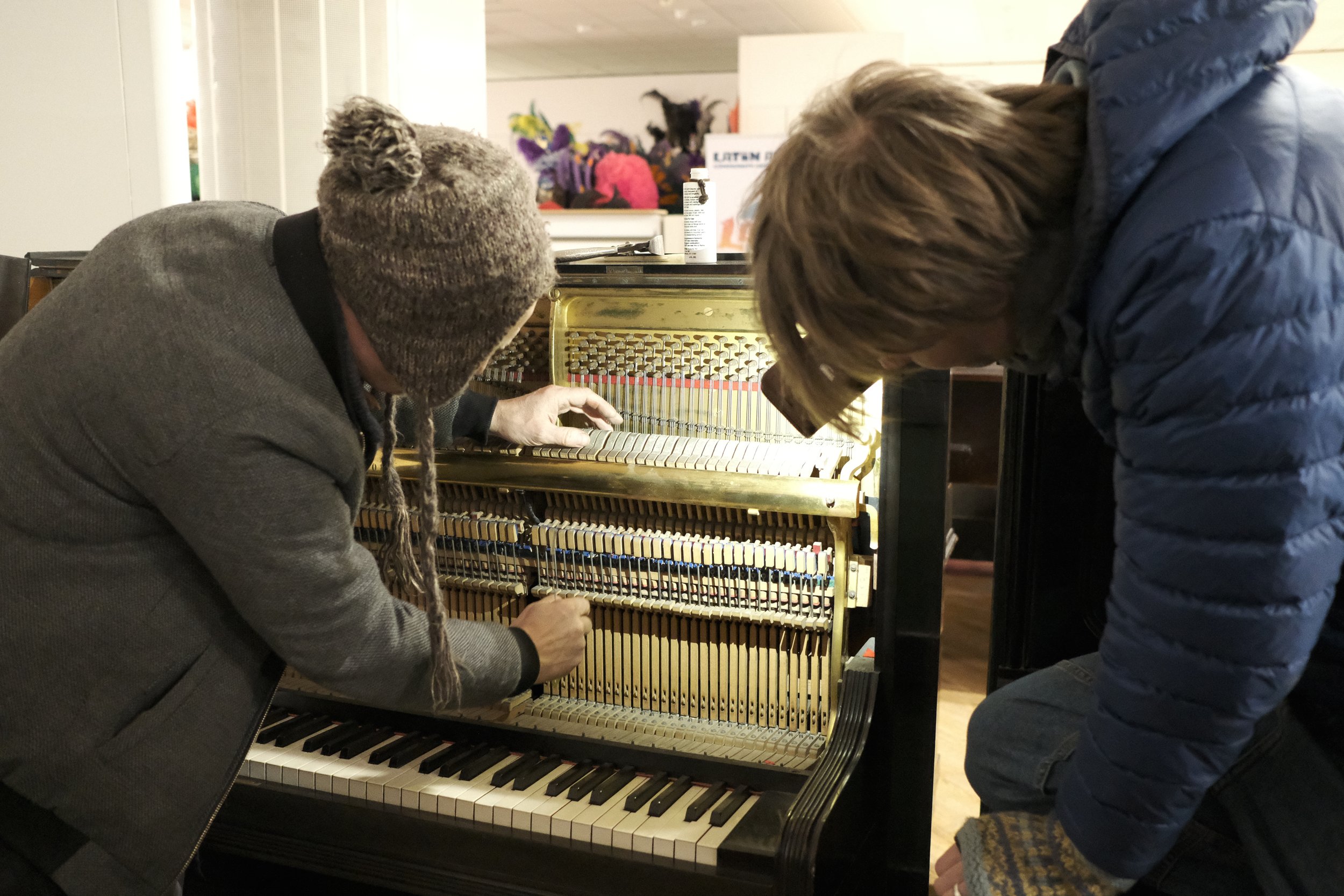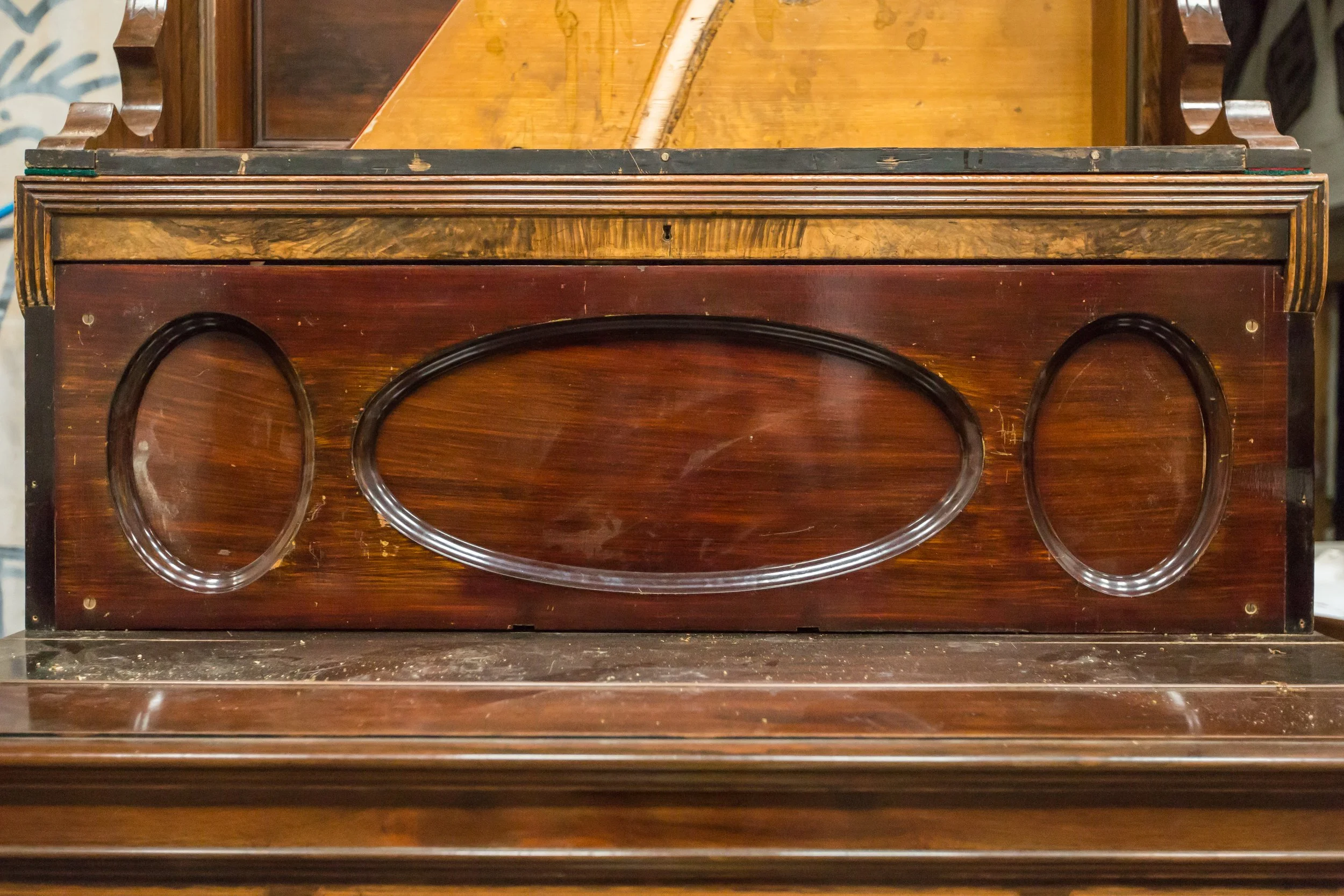
Pianodrome Blog
Piano action in words.
The Blankest of Canvases, Part 2
Fearne and David manning the fort
When I returned to the showroom after a 6 week spell in America the Adopt a Piano scheme had become a more vibey place. Fearne had appeared to play her mesmeric music at the front of the showroom while her dad David invited people in. Jane had found us funding enabling Joel Sanderson and Ben Treuhaft to run fixing and tuning workshops; they imparted revelatory knowledge to us as to which pianos could be saved and which ones were “scrappers”. In June Tom Binns gave a pivotal workshop on how he runs Glasgow Piano City (https://www.glasgowpianocity.org) transforming our fledgling, ad-hoc scheme into a functioning enterprise focused on upgrading pianos before they go back into the wild. More volunteers arrived to help run the project; Alison, Alma, Artem, Davey, Fionn, Georges, Jonny, Kayhan, Laura, Louise, Mirra, Pip and more all helped lift the project off the ground.
A piano saved by the intervention of Louise and Alison
By the end of September we were in full flight and heading for the horizon, that’s when we were given the surprise news that we had one month to vacate the space as it was finally being redeveloped. After setting up and building the project, seeing everyone’s hard work paying off it was difficult to contemplate packing up and trying to start again somewhere else. The windowless, blank void of Debenhams had become a dear home to me; not just because of the showroom days, but all the concerts, piano sharings, magic shows, film screenings, talks and random encounters that had happened there. Furthermore it was also the place where I had found my feet at the Pianodrome, where I had learnt so much and made many friends.
Fionn and me investigating a “bird cage” action
We had just hit the milestone of 100 pianos adopted since opening in January. Our event celebrating this landmark became our closing event for our time at Ocean Terminal. Shona and I worked on a display telling the story of our time there. We had a volunteer showcase in the Pianodrome where Fearne, Louise, Georges and Artem played beautifully, There was a spirited rendition of The Trout Quartet by Tim, Joey, Meg and Chris and a heart warming Piano Sharing to finish.
Shona working on the display, shoppers browsing
We finally moved the last pianos out of Ocean Terminal in January 2024. The electricity had been shut off so we dismantled the Pianodrome in the dusty gloom and coerced the piano cube sculpture down the stationary escalator on a makeshift sledge. Excavators flashed past in the background as we extracted our belongings just in time. As I left what had been the showroom one last time I closed the fire exit door onto the loading bay outside. There was a knack to it that I’d honed through endless practice, giving each half door enough momentum to click into place together, locking me out once and for all.
Everything must go: Tim and Matt dismantling the piano cube before sliding it down the escalator
Recently I wandered over to see the space we once occupied. One year on nothing remains but a pile of rubble and splinters. This time luxury apartments will fill the void for a time. I have to look elsewhere for remnants of our presence there; I have many photos and videos if ever I want to travel back in time. In one video I’m walking through the showroom from the bathrooms at the back. Pianos line the corridor with a couple of punters trying them out, heading to the right we can see the tuning and fixing station; someone is working on a piano on the outer reaches of our orbit. Walking past the sheet music library into the Pianodrome amphitheatre a group of teens are hanging out. Then I follow a family out past the grand piano planters to the front entrance where Georges is playing to his friends and the public at large.
This video shows what can happen when a group of people are allowed to inhabit a space for a while. Given a purpose, community can spring up in the most sterile of environments.
One year on, Adopt a Piano has successfully been transplanted to our headquarters in Granton. Now a couple of mannikins haunt our warehouse reminding us of the time we materialised in an abandoned department store. It’s immensely gratifying that the community which grew there has moved with us too.
Spooky yet reassuring, a momento from our year in O.T
Introducing the Pianometer
Early this year we shot through the landmark figure of 500 pianos donated to the Pianodrome since Tim and Matt started the project in 2017. To recognise the efforts and goodwill of people who have donated pianos to our project and to help visualise the scale of this achievement Georges, Mirra and I have constructed a “Pianometer”.
Using keyboard pin rails to form a grid and felt washers to represent each piano given to us we have created a physical rendering of how many pianos have flowed into Pianodrome.
Once it was made we weren’t sure which way up it should go. Putting the chart vertically highlights its numerical form; the columns fill up satisfyingly from bottom to top, while turning it horizontally makes it read like a narrative; each new washer placed from left to right is another part of the story. We went with the latter, the added benefit being not having to use a small stool to reach the higher pegs.
As of writing, the Pianometer faithfully records that 563 pianos have been donated to the Pianodrome, this is both a very large number for a small organisation such as ours and the tip of the iceberg of pianos floating around the globe. Sadly at present we are unable to take in all the pianos that are offered to us by people in and around Edinburgh. It is an aspiration to serve our community as a home for all pianos which are destined for landfill but currently we do not have the capacity both in resource and space to hold and process all the instruments which are past their play by date.
Of the 563 pianos we’ve received, the majority have gone into our sculpture builds. Over 80 have gone into the making of our two Pianodrome auditoriums, recently three more were added as playable pianos to the Old Royal Pianodrome for our Leeds venture in September 2024. A piano cube sculpture requires six pianos; a half cube three, the piano shed currently based at Middle Meadow Walk, Edinburgh took about three pianos to make plus the one playable inside. Squinting at the 20 foot high Elephant in the Room sculpture from a distance I’d say there’s at least five pianos worth of wood up there plus the three harps on the floor. Most recently two uprights and two grands have been turned into planters for Glasgow school of art and so it goes on as we munch our way through the hundreds of pianos before us. We’re immensely grateful to all the people who’ve pulled apart pianos alongside us.
Plenty of pianos in “The Elephant in the Room”
While the bulk of our work has been turning pianos into sculpture, over 200 pianos have also been rehomed. Many of the pianos received have plenty of life left in them and we’re indebted to all those who have entrusted these pianos to our Adopt-a-piano scheme. By taking the time and effort to donate their pianos to us they both keep real pianos in the world and help the Pianodrome stay afloat financially between projects.
Brinsmead 312 taken for a ride
By cross referencing our paperwork we can use the Pianometer to identify key pianos in our journey and remember pianos which are gone but are not forgotten. Washer 312 signifies a wonderful 19th century “Brinsmead” which has an extremely rare sostenuto pedal for an upright piano. Originally adopted by Meagan it came back to us as it couldn’t fit down the stairs leading to her basement flat. Eight months later it was strapped onto the back of a John Deere utility vehicle and taken down through a forest glen to a cabin in the middle of Tir Na Nog wood where it now resides.
A tree stump piano stool completes the picture
Every washer tells story; number 509 represents a sun bleached “Bechstein” grand piano. It was dropped off one day by Gerry at Edinburgh Piano Moves from a deceased music teacher’s house. Joey, Shona and I spent days totally stripping down and repairing this piano, turning a quirky player into a really good instrument for its new home in Leith. Washer 563; a purple painted “Alison” piano is the latest addition to the chart. Picked up by Tim from Besbrode Pianos in Leeds, Joey and I opened it up on Monday to discover a guinea pig nest inside. Despite this and other more run of the mill drawbacks we’re looking to restore it for a comedy club in town. Or simply just washer 356; “Abbey”, a piano with a lovely tone but some erstwhile moth damage which stayed with us in the showroom for a total of 15 months before finally finding its new home. I could go on…
Alison 563, a nice sounding piano despite the obvious
With this chart we now have a living document of all the pianos which pass through the Pianodrome. It has become our piano hall of fame and infamy and we would encourage anyone who has donated or adopted a piano to come and sign a paper washer and place it on their designated peg. This can be done at the Adopt a piano showroom every Saturday 11-3:30.
However, before I get too carried away by this new innovation I have an admission to make. Nobody knows the exact number of pianos donated to the Pianodrome. We only started logging pianos systematically when Adopt a Piano started in January 2023 and used a conservative estimate of 300 pianos donated between 2017-2023 as a safe-to-assume basis. We may actually be gliding through the seven hundreds at this point, history does not record so precisely. This raises questions for us of how do we faithfully keep track of what we’ve done as we dash forward from one adventure to another? If each one of these washers is a moment in our history, how many more have gone past unregarded?
As the reassuring solidity of data has started to fray perhaps it’s better to give in to the randomness of colours rather than seek the pattern. Stepping back I can say ultimately making the Pianometer is an attempt to mark the contribution of our piano donors to the Pianodrome. Each variegated washer on the board is a token of our appreciation to all those who have helped us flourish by donating their instrument to us. The result is a vibrant, growing profusion of colour.
Washer 356 “Abbey”
The Blankest of Canvases, Adopt a Piano adventures in an ex-department store (part one)
Tomorrow we are heading into the dust shrouded remains of Debenhams at Ocean Terminal shopping centre in Leith to extract the final 35 pianos left from our time there. It’s been just over a year since Tim and Matt brought the Adopt a Piano scheme to national attention via this BBC story about saving 100 year old pianos from landfill https://www.bbc.co.uk/news/av/uk-scotland-64175072
That article brought to life an entire ecosystem of pianos coming in to us to be cleaned, repaired, tuned and regulated before heading back out to new homes. Due to the success of the Adopt a Piano scheme staff and volunteers are now learning how to bring pianos back to life, revitalising a dwindling profession of piano restoration and more people are choosing to have these soulful instruments in their homes rather than a digital facsimile. That’s how things have evolved, but in the beginning it wasn’t quite so finessed.
Angus working on the newly arrived Pianodrome
The vast, empty space in the ex-Debenhams department store ground floor (lent to us by the good folk at the Wee Hub for six months or so) was the perfect breeding ground for the piano adoption scheme. Flying from its majestic roost at the Old Royal High school on Calton Hill the Pianodrome Amphitheatre touched down in the void of this abandoned, soon to be demolished half of Ocean Terminal shopping centre. The contrast was immense; a sunlit, wood panelled room had been exchanged for an all-white landscape of strip lighting, forgotten mannikins and a beep which emitted every thirty seconds from somewhere unknown.
Having sent out the call that we would take in any piano, overnight pianos of all descriptions appeared as if springing up from the beige floor tiles. I got a call from Matt to come down and help work out what to do with them. I found him deep in the midst of about 50 pianos, marvelling at the rich diversity of instruments we’d taken ownership of. Already hand written notes had appeared on several lids as people had somehow snuck in under the security shutters to reserve a good one. We roughed out a few details on how to proceed, placed a notice on social media and the website and I offered to open the showroom on Thursday to see what happens.
Potential adopters at the entrance
It was chaotic, but good chaos, and thank goodness people came to adopt our first flush of pianos. With several groups pouring over the pianos, we tried to stay one step ahead and grasp the adoption process and administration of the project on the fly. There were incredible pianos going out the door in return for any donation to the Pianodrome. The donations we received allowed us to start to fund aspects of the showroom as well as keep the Pianodrome company afloat in the lull between projects. Three or four pianos left each time we opened. Every Saturday a flurry of folk would come in seeking out a piano for their homes, during the week emails kept our administration legend Laura busy. A group of us emerged to hold the project as it grew, Mirra and Alison’s knowledge of tuning pianos was invaluable. Jonathan gave us business advice to steer the project. Pip helped with our first tentative steps towards fixing pianos and Shona worked out a system of logging our stock with Alma.
Tim wheeled out a piano to the front entrance to make a reception area and those who knew a tune took turns playing for the general public as they drifted past us towards the Royal Yacht Britannia elevator. Some tourists beguiled by the music diverted our way and followed a long, snaking line of pianos to the back of the room where the Pianodrome structure enveloped them. Word of mouth spread in Edinburgh and pianists of every ability and style turned up to play in the cavernous nowhere land of the old Debenhams, either out front, in the Pianodrome amphitheatre itself or randomly, delightfully, at a piano in some corner somewhere. The atmosphere of the room would change in an instant with the first notes of an unexpected song appearing from thin air and then transform dramatically again as a young child joined in with their first improvisational piece on another piano elsewhere.
Adoption station
In March I left for America to help build the world’s third Pianodrome and Shona, having dedicated hours of time volunteering since its inception, stepped up to run the project. I had mixed feelings about handing over the reigns. I knew she would do a great job but worried about the viability of the project. Adoptions had tailed off but the deluge of pianos coming in had not. Over 90 upright and grand pianos now littered the space around the Pianodrome structure, at this rate we were going to need a bigger department store to keep them all in. Donations could only cover the bare bones of the project, we needed to ask people to dig deeper into their pockets if we were to fully realise the potential of the project. As well as lacking the funds to work on the pianos which could be saved we lacked the knowledge to know which pianos were salvageable and which were merely decoration. Fortunately in my absence heroes emerged to move the project forward immensely. I’ll talk about them next time.
Joey and me, investigating
If you'd like to get involved with the Adopt a Piano scheme drop us an email at adopt@pianodrome.org
